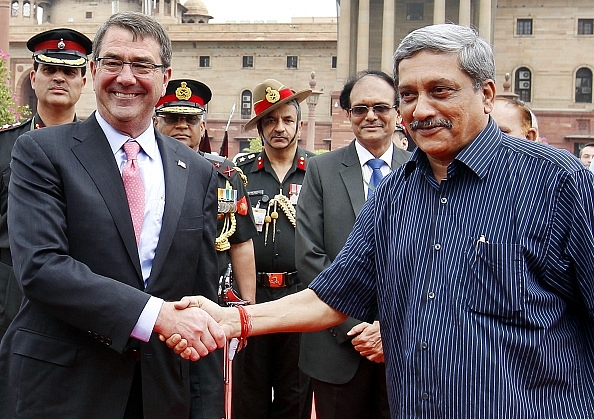World
U.S. Defense Secretary In India: A Foundational Visit
- The recent visit of the U.S. Defense Secretary to India has yielded significant outcomes on streamlining bilateral military interactions, deepening maritime security cooperation and defence technology collaboration. As India grows closer to the U.S., it should be clear about the objectives of this engagement

Carter with Mr. Parrikar/Getty Images
By Sameer Patil
This week, the U.S. Defense Secretary, Ashton Carter, concluded an important visit to India which is his second in less than a year, reflecting the momentum that the bilateral defence relationship has acquired during his tenure.
There were three significant outcomes of Secretary Carter’s visit. One, the in-principle understanding between both sides to sign the Logistics Exchange Memorandum of Agreement i.e. Lema; two, the establishment of the maritime security dialogue and three, the initiation of new pathfinder projects as part of defence technology cooperation.
The Lema is an enabling arrangement between India and the United States to provide their bases, fuel and other kinds of logistics support to each others’ fighter jets and naval warships. The text of the agreement is not yet finalised but it is a variation of the Acquisition and Cross-Servicing Agreement, which the U.S. has with its many of its Nato allies.
The agreement is part of the trinity of the so-called ‘foundational’ defence agreements along with the Communications and Information Security Memorandum of Agreement (CISMOA, for interoperability between the Indian and the U.S. military equipment) and the Basic Exchange Cooperation Agreement enabling the exchange of geo-spatial information which the U.S. had been urging India to sign since 2005. For a decade, India prevaricated. Its main concern was two-fold: it didn’t want to lose autonomy in its foreign policy dealings, nor get embroiled in conflicts which it had no stake in.
The second important outcome of the visit was the decision to establish the bilateral maritime security dialogue. This follows the January 2015 India-U.S. joint statement, which stressed freedom of navigation, particularly in the South China Sea , a proposition reiterated in the joint statement issued after the meeting of Secretary Carter and Defence Minister Manohar Parrikar on April 12 in New Delhi.
While India is reluctant to actualise that commitment through joint patrols in the South China Sea region as suggested by Admiral Harry Harris of the U.S. Pacific Command, it is taking other steps with the U.S. to address that commitment. These include an agreement for information sharing on commercial shipping traffic and, more importantly, navy-to-navy discussions on submarine safety and anti-submarine warfare. This will surely raise hackles in Beijing.
Last year, India and the U.S. had signed the new framework for defence relationship, under which special emphasis was given to defence technology codevelopment and coproduction. Four ‘pathfinder’ projects, experiments in making simpler technologies and easy to produce equipment had been identified as part of this. These projects are particularly important given India’s own slow and difficult experience in indigenously developing and producing some of these basic technologies. The MEHPS system, for instance, will be useful for the army units deployed in the remote and high-altitude locations of Jammu and Kashmir and in the Northeast.
India-U.S. defence technology collaboration
During Secretary Carter’s visit, two new pathfinder projects, Digital Helmet Mounted Display i.e DHMD and Joint Biological Tactical Detection System i.e. JBTDS were identified. Again, both systems are critical technologies, particularly the DHMD, which may become an important component of India’s own efforts to put in place ‘Soldier as a System’ project and the Indian Army’s efforts towards acquiring ‘network-centric warfare’ capability. Cooperation has also been announced on four advanced science projects (see table).
This progress is impressive. But the deepening bilateral technology collaboration doesn’t yet benefit Indian private defence companies as all the above-mentioned projects are government-to-government. Discussions on the modalities of the implementation of the two pathfinder projects which do involve the private sector which are the Raven UAV drone and surveillance kits for the C130 transport aircraft are still ongoing. Involving the private sector in these arrangements is critical for creating a robust defence industrial base in India.
Secretary Carter’s visit has given a critical impetus to the India-U.S. bilateral defence relationship, especially as it runs parallel with the continued U.S. military assistance to the Pakistan Army which involved first selling F-16 fighter jets and recently AH-1Z attack helicopters which has generated much animosity against the Obama administration in the Indian policy establishment.
Sameer Patil
is Fellow, National Security, Ethnic Conflict and Terrorism, at
Gateway House.
The article was first published in Gateway House.
Introducing ElectionsHQ + 50 Ground Reports Project
The 2024 elections might seem easy to guess, but there are some important questions that shouldn't be missed.
Do freebies still sway voters? Do people prioritise infrastructure when voting? How will Punjab vote?
The answers to these questions provide great insights into where we, as a country, are headed in the years to come.
Swarajya is starting a project with an aim to do 50 solid ground stories and a smart commentary service on WhatsApp, a one-of-a-kind. We'd love your support during this election season.
Click below to contribute.
Latest